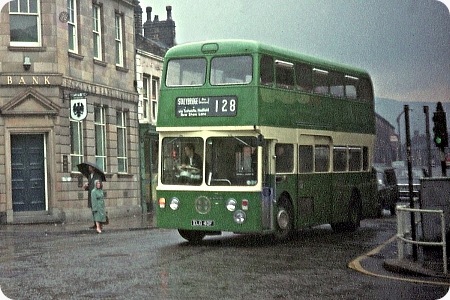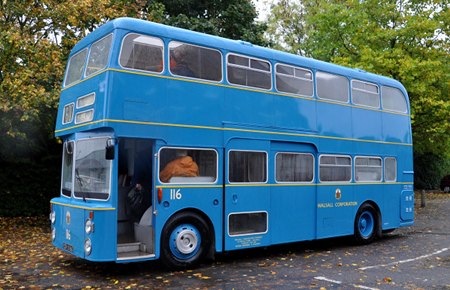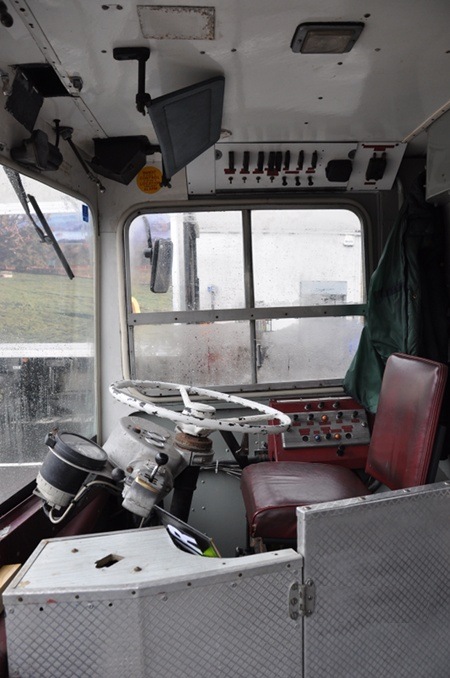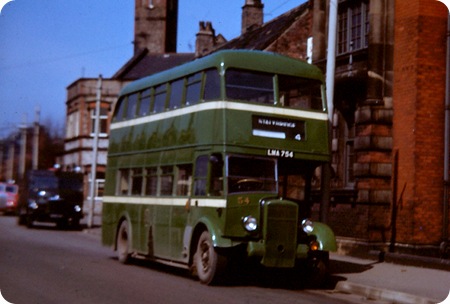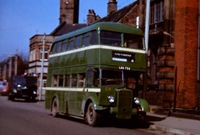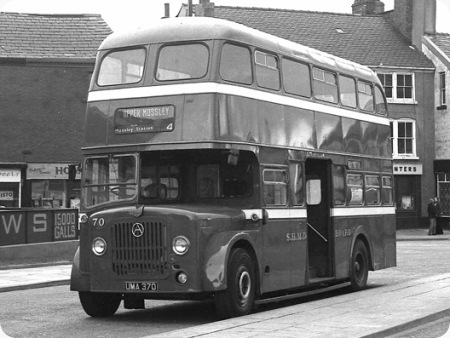
Copyright David Beilby
Stalybridge, Hyde, Mossley and Dukinfield
1955
Atkinson Mk II (6LW)
Northern Counties H35/25CD
Following on from Roger Broughton’s comments on the S.H.M.D. Daimler CVD6 posting I thought it might be appropriate to post this view of the preserved S.H.M.D. Atkinson double-decker in Stalybridge bus station on 30th April 1978. The location still contains many props used for the filming of ‘Yanks’ and the less kind may have commented that Stalybridge had to be modernised to bring it up to the 1940s setting for the film!
I encountered some of the filming here by chance. I arrived at Stalybridge on the late train from Leeds (the one-time York – Aberystwyth mail train) and saw a pool of light coming from the town centre. Going over to investigate I found in the bus station the two Keighley-West Yorkshire veterans (JUB 29 and CWX 671) given those Stalybridge and District fleet names and dirtied in a very effective manner. Also on standby was a Grey Cars Regal III which was even less historically accurate. I don’t recall much of this footage escaping the cutting room floor.
Photograph and Copy contributed by David Beilby
14/04/11 – 05:00
Not sure about the Atkinson Mk II heading – surely this was a PD746 or possibly a PD746S, I’ve seen both versions used. And if it was a "Mark II" then what was a "Mark I"? Whatever its official designation it remains a lovely machine and thank heavens that it was preserved for posterity.
Neville Mercer
27/04/11 – 07:28
One-off designs tend to have a short and unsuccessful life due to lack of proof testing that volume production brings but the Atkinson double decker seemed to have a full and active service life with SHMD. This is perhaps because it was built from well proven major component parts, ie a Gardner 6LW engine and I believe a Self-changing Gears semi-automatic gearbox. It is a great pity Atkinson did not produce more double-deckers as they obviously got the package right.
Their sortie into single-deck production was largely at the behest of some North West operators who wanted a robust Gardner engined vehicle on the lines of the Bristol MW which was not available to non-BTC companies in the 1950’s. Atkinson supplied the Alpha saloon to LUT, North Western and SHMD at this time.
LUT was fairly well wedded to Guy Arabs for its double deck purchases and North Western, requiring low-height vehicles chose the Dennis Loline so apart from the solitary SHMD vehicle there were no other double-deck deliveries from Atkinson.
I have ridden on no.70 at Boyle Street and I agree it is a splendid machine. The centre-entrance makes it a doubly unusual vehicle. I understand this came about as the general manager at the time came from Blackpool and was influenced by those splendid Burlingham PD2’s.
Philip Halstead
27/04/11 – 13:19
Thank you David for the extra info regarding other buses readied for the film
Roger Broughton
14/11/11 – 17:43
Arthur Brearley, the HPTD driving instructor during the 1960s, told me that the Atkinson PD746 was seriously considered by Halifax in the 1950s. In the event, further Daimlers arrived.
Roger Cox
29/11/11 – 17:03
When 70 bus Atkinson DD was delivered new it was fitted with a David Brown gearbox not a lot of people know that
Old Bus Driver
01/12/11 – 07:43
I haven’t watched the excellent film "Yanks" for a good while now, but much of it was filmed in Keighley and I think the bus concerned was Keith Jenkinson’s Keighley-West Yorkshire Titan JUB 29 wasn’t it ??
Chris Youhill
01/12/11 – 07:44
Yes it was Keith Jenkinson’s JUB 29 Chris. I remember it spending a short time in West Yorkshire’s Body Shop for a general sprucing up after filming had finished. It was tucked snugly in the back left-hand corner (viewed from Westmoreland Street) and achieved almost ‘local celebrity’ status with some of the older staff during its brief stay. Like you, I’ve never seen the film, but know that quite a lot of the scenes were shot around Keighley and its railway station. That would tie in very nicely with the Keighley-West Yorkshire vehicle, not to mention the splendid engines of the Keighley & Worth Valley Railway.
Brendan Smith
01/12/11 – 07:45
David Brown was a prolific supplier of gearboxes to lorry builders such as the likes of Atkinson, Foden and ERF in the 40’s 50’s and 60’s, usually mated to Gardner engines, so I wouldn’t be surprised that the only Atkinson double decker was so supplied. What I do not know is was David Brown gearboxes as popular with the bus chassis builders of the period?
Eric
01/12/11 – 15:21
About D Brown gearboxes SHMD had 2 Daimler dds with DB gearboxes and they were nice to drive unlike the Atkinson dd which was orible, very slow change and very heavy steering.
Old Bus Driver
04/12/11 – 07:55
Bus manufacturers had a stronger preference for making their own gearboxes than lorry builders, but the users of David Brown gearboxes in PSVs I know of were BMMO (all postwar manual transmission models I think), Tilling-Stevens, Atkinson (Alpha), Bristol (SC4LK) and Daimler (CSG). The Daimler CSG was overtaken by events, soon being replaced by the CCG with Guy transmission when Daimler and Guy came under common control.
Peter Williamson
05/12/11 – 06:40
Thank you for that info. Peter.
Interesting to note that of the five chassis makes/models you list three of them would have been fitted with Gardner engines. What would be the normal engine choice for the Tilling-Stevens?
Eric
05/12/11 – 16:46
The immediate post-war Tilling-Stevens Express models certainly had David Brown gearboxes and those I know of had Gardner 5LW or 6LW engines. The majority of post-war Expresses went to Hong Kong. They were sound chassis and these engines/gearboxes gave them great reliability. (One, I believe, has survived). Were that other chassis builders of the time – Crossley in particular, had done the same.
Chris Hebbron
06/12/11 – 06:39
The Bristol SU chassis also utilised a David Brown (5-speed) gearbox, but for some reason Bristol turned to Turner (no pun intended!) for gearboxes on the LH. Funny how to many of us, David Brown gearboxes seem more associated with lorries than buses, as Eric says. It’s interesting to learn that BMMO and Tilling-Stevens also used them. As an aside, when David Brown purchased Aston Martin many years ago, the letters DB were used on consecutive new models over the years, to denote the ownership.
Brendan Smith
08/12/11 – 06:38
The alternative to Gardner engines in postwar Tilling-Stevens models was Meadows. The survivor, GOU 732 from memory, originally had a Meadows engine but now has a Gardner 6LW.
Peter Williamson
08/12/11 – 15:35
Following on from my post above, for what it’s worth, here’s a link to the Hong Kong Tilling-Stevens Express survivor: //cmchk.no-ip.org/
If memory serves me, I believe that Hong Kong had the largest fleet, well over 100, of post-war Tilling-Stevens in the world and they lasted over 20 years in service.
Chris Hebbron
16/04/12 – 07:38
So pleased to read about the Atkinson 70. Took me into Manchester(Schooldays) daily when on the splendid fast 125 Glossop Hyde Manchester limited stop service in the fifties!. I remember drivers struggling with the gear box when it first came into service. A lovely vehicle to ride on but never up to the speed of the CVD6 vehicles 23-24-25 that worked the 125 so regularly. Great days – SHMD was transport at its best – and yes – we always called it "the Joint Board"
Roger Chadwick
07/10/12 – 08:32
I came across the ‘S.H.M.D. No.70’ correspondence purely by chance. I travelled on the Atkinson bus in the mid-60s and remember its sluggish performance compared to that of the six, similarly-bodied, Daimlers bought by S.H.M.D. whose last two, open-platform, Daimler doubler-deckers-dating from 1959-seem to have been unpopular with drivers because of their ‘awkward’ (David Brown) gearboxes: one of them was heard to say that you could ‘have a meal’ in the time that it took to make a gear change. Given the hilly nature of the S.H.M.D.’s operating area, one wonders how such apparent ‘lemons’ came to be bought at a time when the Joint Board was taking its first Leyland PD2s that seemed to take very steep routes in their stride (unlike those PD2s operated by Manchester on shared routes). Lancashire United bought a 1959 Guy Arab (now preserved) which also had a David Brown gearbox: enthusiasts who test-drove this bus on a ‘flat’ circuit found the ‘box ‘tricky’ when selecting gears but were otherwise quite satisfied with it.
John Hardman
07/10/12 – 11:29
Philip Halstead said that the Atkinson single decker was designed and built at the behest of "some" North West operators.
It was more specific than that. North Western Road Car was, to say the least, miffed to find itself remaining under the BET banner after the 1947 Transport Act which nationalised the Tilling companies in whose company NW, a dedicated Bristol user, felt at home.
With the Act due to become law in 1948, and aware of long delivery times, NW ordered 122 Bristol single deckers before the terms of the Act restricted Bristol purchases to the nationalised Tilling Group.
The last of these were delivered in 1950. Double deckers were in the minority in the fleet and NW was seemingly happy with its PD1 and PD2 purchases in the late 1940s and plans to re-body its 1938/9 K5Gs and austerity Guy Arabs with Northern Coach Builders bodies, chosen because a senior NCB manager was ex-Eastern Coach Works. A spanner was thrown in the works when NCB suddenly closed on the death of its owner and the re-bodying contract passed to Willowbrook.
Much of the double decker territory was relatively flat around Stockport, Manchester and out on the Cheshire Plain. The singles however had to tackle parts of the Pennines and the Peak District and the Gardner powerplant was deemed necessary.
The problem was the favoured Gardner engine was only available powering products from Coventry, Wolverhampton Sandbach and Guildford – none of which suited. A massive rebodying programme of the pre war Bristol singles was implemented and what were effectively "new" Bristols continued to appear until 1952 after which further complex body swapping went on well into the late 1950s.
In 1949 Atkinsons were approached by NW Chief Engineer H Stuart Driver and they agreed to build a single decker to NW’s "proxy Bristol" requirements.
The first two with Weymann bodies arrived in 1951 and were compared to two Leyland/Weymann Olympics. Whilst they had rear entrances, compared to the Leylands’ front entrance, everything else was vastly in their favour.
A further 14 followed in 1953, the last two were bodied by Willowbrook as "lightweight" vehicles with single rear wheels, the last had a 4 cylinder Gardner engine in place of the 5LW but was found to be unsatisfactory.
An order for 100 5LW powered lightweights was placed but this was countermanded by the BET main board. Stuart Driver made a presentation to the BET main board showing the benefits of the Atkinson against the BET now preferred Leyland Royal Tiger. His presentation was rejected.
He caught the first train back to Stockport, cleared his desk and walked out. NW, for better or worse got Royal Tigers and later Tiger Cubs. The Atkinsons gave around 13/14 years service and, had they been front entrance, would have lasted longer in OMO service.
I rode on these to school many times and they were quick, though the rear entrance with steep steps didn’t help loading and unloading.
Meanwhile LUT had been watching developments between NW and Atkinsons and ordered vehicles which were to be delivered in 1952 with front entrance bodies on 6 and centre entrance bodies on 4. Between 1952 and 1955 LUT amassed no less than 40 of the type.
SHMD was a dedicated Thorneycroft user. When production of Thorneycroft buses ceased, their allegiance changed to Daimler. They bought a Freeline single decker in 1952 fitted with a centre entrance standee 60 passenger capacity body. The body was deemed a success, the chassis wasn’t, so follow on orders for the body were placed on Atkinson chassis. The deliveries between 1953 and 1956 were centre entrance, the last in 1959 were front entrance but were arranged with 34 seats and a standee area for 26.
A total of 7 single deckers and the double decker were purchased by SHMD, the double decker being an attempt to find an alternative to the Daimler chassis then dominating the double decker fleet.
When Frank Brimelow took over as SHMD General manager in 1956 he took two batches of PD2s. These had fully rated 0.600 engines – the reason they outperformed their Manchester counterparts which, under Albert Neal’s parsimonious pursuit of economies, de-rated his engines to 100bhp.
Had NW got its way, had the double decker been built for a more substantial operator, had the prototype not been with an oddball body layout, had the Bamber Bridge facility been larger, had ifs and ands been pots and pans……………you know what I mean.
Phil Blinkhorn
07/10/12 – 13:35
During the brief period when I was a Schedules Clerk at SELNEC in the early 70’s, I worked with a chap called Peter Caunt who had worked at North Western, both in the offices and as a driver.
In his inimitably enthusiastic manner he recalled driving the Atkinsons, which he referred to as the ‘fastest coal lorries in the north’. He said they were very quick – even more so than the Reliances – but that they had very heavy steering and gearchanges making them hard work for a full shift unless you were built like Goliath. The accelerator pedal was of the organ type, which at only low revs had already reached a horizontal aspect. Pressing down any further caused the pedal to point downwards towards its front end causing great discomfort to one’s ankle – especially on a long hill climb. Drivers resorted to attaching wooden wedges to the pedal to alleviate the problem.
I remember him telling me how one of them had suffered a gearbox failure and an ‘engineering team’ was despatched by the manufacturer to replace it. When they turned up they were mistaken for gypsies and almost thrown off the premises. ‘A right pair of toe-rags’, Peter quoted, they were not allowed into the works, so the bus was shunted into the yard and they did the entire job under the crudest of conditions using just brute strength and with the meagerest of tools.
Years later (1984) he went on to write his bus driving memoirs in ‘North Western – A Driver’s Reminiscences’, to which I have referred to jog my memory. It still turns up regularly on bookstalls at rallies.
John Stringer
09/04/13 – 17:47
I was a fitter at North Western at Stockport for 10 years. The Atkinson Alfa’s had 5HLW Gardners and we had some with 6HLW Gardners these all had Atkinsons own gearboxes (copy of D Brown), not very good. We had two light weight Alfas with single rear wheels these had 5HLW Gardners and genuine David Brown gearboxes.
Geoff Burgess
03/02/16 – 14:39
Regarding SHMD 70 Atky it was a great bus to drive. The steering was very heavy indeed.
It was used for the express route from Manchester where it left and did not stop until it was in our area. The shift was I think 4 times per evening and everyone (just once fell for it) though it was a good payer but in reality it was a full duty. Once it got going it Flew!! Stopping was a concern.!! It used to terminate in Carrbrook I think (a long time ago so could be wrong). Happy day’s.
Philip Worley
04/02/16 – 13:25
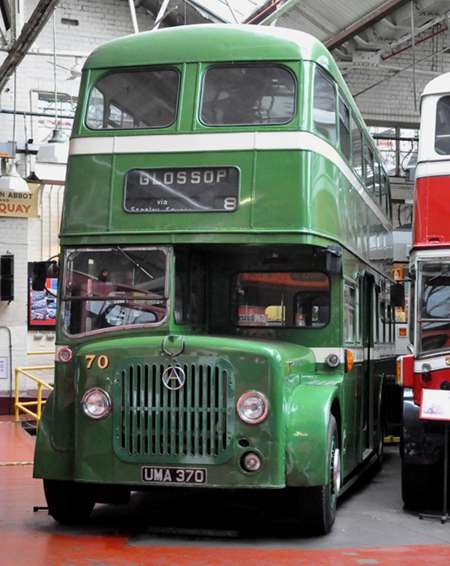
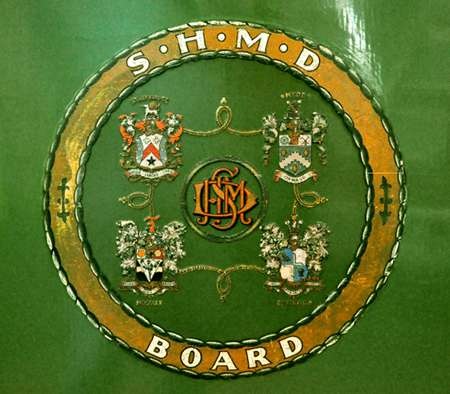
As many readers of these columns will be aware, this was the only double decker Atkinson ever built, and according to various sources this was one of the reasons they declined an invitation to produce a clone of the Daimler Fleetline. That clone became the Dennis Dominator.
UMA 370 managed to join the ranks of the preserved, and we see her in the GM Museum at Boyle Street on 19 August 2012. Conditions there were a little cramped, to say the least, at the time of my visit. Still, I did capture a view of the Crest.
Pete Davies
04/02/16 – 16:54
As many people will be aware, the "knight" radiator mascot from this vehicle was stolen from the Boyle St museum recently. It is believed to be unique, so if anybody notices it anywhere please get in touch with the GMTS website. Incidentally, does anybody know why Atkinson put a knight motif on it in the first place? I’ve always suspected that they were sort of imitating Guy’s Indian chief mascot.
Neville Mercer
05/02/16 – 06:38
The knight motif was an allusion to the expression "Knights of the Road", a term that was once, but emphatically not nowadays, applied to the lorry driving fraternity.
Roger Cox
06/02/16 – 06:55
Oh, Roger! There are, as we all know, some bad eggs in the bus industry as well, but the professional truck driver is several rungs further up the ladder of ‘knighthood’ than the average white van man . . .
Pete Davies
06/02/16 – 06:55
In the 1960s Atkinson produced a range of lorries with ‘Knight’ in the name – Black Knight, Gold Knight and Silver Knight spring to mind – and appropriate badges were often seen attached to the radiators. This has triggered memories of W J Riding’s immaculate fleet of dark blue and silver-grey Atkinson lorries, which were a familiar sight on the roads at that time.
Brendan Smith
14/07/17 – 07:34
18 months on; did the missing mascot ever turn up? Has anyone tried to make ‘a reasonable facsimile’ of it,using images to work from?
John Hardman
30/10/19 – 06:59
This bus now has a matching set of recessed front wheel centres for the first time since 1971. A swap of wheels at Stalybridge with the just restored 70 and the then withdrawn Daimler 61 has been reversed. The Atkinson had recessed centres to allow Atkinson aluminium hub covers. Sadly still no sign of the Knights Head rad badge.
Neil Kenworthy
 Vehicle reminder shot for this posting
Vehicle reminder shot for this posting
30/05/21 – 06:56
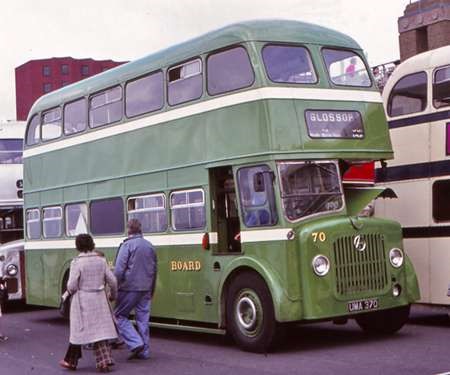
During these damp May days, I have come across this photo taken at Blackpool Rally on August 21 1977. I have a scribbled note that it was owned by GMPTE at the time.
Geoff Pullin
